Quaker City Focus
The Quaker City; Or, The Monks of Monk Hall. (Philadelphia, 1844). By George Lippard. Lippard’s Quaker City has been called “the most extravagant compound of Gothic terror, intense melodrama, and social invective ever written on this continent.” Lippard himself said it had been “more attacked and more read than any work of American fiction.” Taking place over three days and even scarier nights, the novel is set in a decrepit South Philadelphia mansion that is 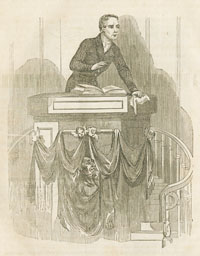 equal parts brothel, opium den, and private club, patronized by the city’s elite professionals. And there are three main plots, all involving murder and debauchery by loveable characters such as Monk Hall’s monstrous concierge, Abijah K. Jones (aka “Devil Bug”), whose duties include keeping those trap-doors working, toting corpses to the cavernous basement, and drugging female guests; and the fiery Reverend Doctor F.A.T. Pyne, a Catholic-baiting, congregation-bilking, cocktail-abusing dad who tries to rape his maidenly, bosom-heaving, sedated daughter Mabel. You get the idea.
equal parts brothel, opium den, and private club, patronized by the city’s elite professionals. And there are three main plots, all involving murder and debauchery by loveable characters such as Monk Hall’s monstrous concierge, Abijah K. Jones (aka “Devil Bug”), whose duties include keeping those trap-doors working, toting corpses to the cavernous basement, and drugging female guests; and the fiery Reverend Doctor F.A.T. Pyne, a Catholic-baiting, congregation-bilking, cocktail-abusing dad who tries to rape his maidenly, bosom-heaving, sedated daughter Mabel. You get the idea.
Left: George Lippard. “Memoirs of a Preacher.” in The Quaker City. A Saturday Paper for Universal Circulation. (Philadelphia, January 13, 1849). The success of his Philadelphia city mystery novel bought Lippard a Christmas present in 1848 – his very own periodical, of the same name, which saw its first issue just before New Year’s Eve and soon boasted a circulation of 10,000. He used it to promote Whig-leaning social reforms and his own literary work. This issue serialized one of his novels, an attack on corrupt and lascivious clergy. The illustration was reused as a frontispiece when the text appeared in volume form. Hey, what’s that nasty little demon doing there under the pulpit?
_______________________________________________________________________________________
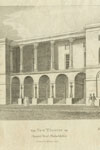 |
William Birch. The New Theatre in Chesnut Street Philadelphia. Aquatint. (Philadelphia, 1823). |
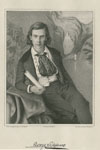 |
Albert Newsam. George Lippard. Lithograph by P.S. Duval from a daguerreotype by J.E. Mayall. (Philadelphia, 1844?), Historical Society of Pennsylvania. |
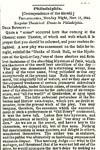 |
Peter Peep & Co. “Singular Theatrical Events in Philadelphia. Monday Night, Nov. 11, 1844.” The New York Herald, Wednesday Morning, November 13, 1844). The Quaker City nearly caused a riot when it was slated to be performed as a play at the Chestnut Street Theatre. The real life inspiration for the novel’s villain was socially prominent cad Mahlon Heberton, who seduced the sister of Singleton Mercer. Mercer shot Heberton and was acquitted in a sensational trial. Hoping to make the play a success, Mercer bought 300 tickets for “The Monks of Monk’s Hall” (as the play was to be called) and distributed them on the streets, allegedly to “regular Southwark rioters.” It had been barely four months since Nativist riots there had sullied the reputation of Philadelphia nationally, and the mayor, fearing another riot, canceled the show. Philadelphia papers hushed up the incident, but the vituperative New York Herald reported that “all the world of Quakerdom is agog upon the subject.” |
[George Lippard]. The Quaker City. Parts 5 and 7. (Philadelphia, 1845). Historical Society of Pennsylvania. This is the way Lippard’s soon-to-be smash best-seller looked when it was first issued in weekly parts. At that time it was just another entry in the new “City Mystery” genre derived from the French novelist Eugene Sue’s The Mysteries of Paris (1842-1843). The wrapper illustration is by DeWitt C. Hitchcock. The fifth part also included a pair of related wood engravings signed by “Quis” that are among the earliest works of the great book illustrator Felix Octavius Carr Darley (1822-1888). In a little-known link in the Philadelphia Gothic tradition, Darley grew up in the house once occupied by Charles Brockden Brown. |
|
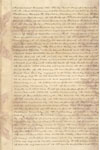 |
H[enry]. B[eck]. Hirst. Agreement between George B. Zeiber and George Lippard. . . . Manuscript. Philadelphia, March 31, 1845. Historical Society of Pennsylvania. The Quaker City was projected to fill four parts, but Lippard decided to extend it in a “sequel,” and so it was still being written and still appearing in parts in March 1845 when he entered into a new contract with publisher G.B. Zeiber. Perhaps because the book had been such a hit, the new contract was unusually advantageous, giving him a full 50% of all the profits. Lippard is identified as “Novelist,” which was also unusual in author contracts and emphasizes his desire to be seen as more than just a muckraking journalist. The scribe and witness to the document was Henry Beck Hirst, Poe’s best drinking buddy in his years in town. |
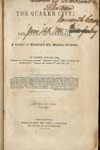 |
George Lippard. The Quaker City; or, The Monks of Monk Hall. A Romance of Philadelphia Life, Mystery and Crime. 27th edition. (Philadelphia, 1849). Once the book was finished and out, Lippard renegotiated his contract in an even more advantageous way. He became full owner of the copyright and the electrotype plates from which the book was printed, and from then on he was the publisher. This 1849 edition, said in the preface to be the 27th, his name appears on the title page and the imprint reads “Published by the Author.” Now that its reputation was secure, he rededicated it to Charles Brockden Brown, thereby forming another link in what was now the Philadelphia Gothic tradition. |
George Lippard. The Quaker City; or, The Monks of Monk Hall. A Romance of Philadelphia Life, Mystery and Crime. (Philadelphia, 1876). Within a year The Quaker City had sold an astonishing 60,000 copies, a one-year sales record for an American novel not topped until Uncle Tom’s Cabin appeared eight years later. (By comparison, Moby Dick sold 2,500 copies in its first five years.) It continued to sell steadily through the end of the century as a paperback, still carrying the sensational illustration by D.C. Hitchcock that had appeared in a slightly different form on the wrappered parts in 1844. |
|
[George Lippard.] The Quaker City; or, The Monks of Monk Hall. A Romance of Philadelphia Life, Mystery and Crime. (Philadelphia, G.B. Zeiber, 1844). The March 1845 contract was only meant to be in force for three months, possibly the time Lippard thought it would take to finish the book. Once it was finished, Zeiber stopped the part issues and published the full text in regular book form. The volume was dedicated to Augustine J.H. Duganne, who had just published another “city mystery” novel that included a long-haired character not unlike Lippard, who exposed the evils of Philadelphia. Courtesy of The Historical Society of Pennsylvania. |
|
Click Here for Guide to Research on George Lippard (PDF) |
|
NEXT: The Return of the Regicides >
![[George Lippard]. The Quaker City. Parts 5 and 7. (Philadelphia, 1845). Historical Society of Pennsylvania.](images/th5.5.jpg)
![[George Lippard]. The Quaker City. Parts 5 and 7. (Philadelphia, 1845). Historical Society of Pennsylvania.](images/th5.6.jpg)


![[George Lippard.] The Quaker City; or, The Monks of Monk Hall. A Romance of Philadelphia Life, Mystery and Crime. (Philadelphia, G.B. Zeiber, 1844).](images/th5.11.jpg)
![[George Lippard.] The Quaker City; or, The Monks of Monk Hall. A Romance of Philadelphia Life, Mystery and Crime. (Philadelphia, G.B. Zeiber, 1844).](images/th5.12.jpg)